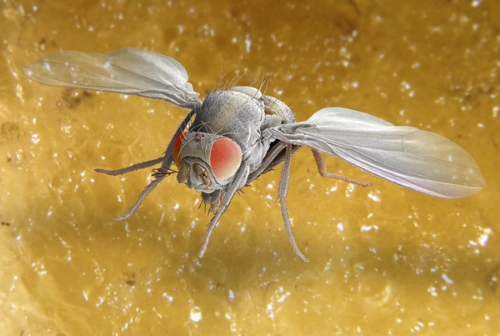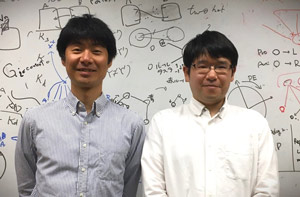
Figure 1: Colored scanning electron micrograph of a fruit fly on a banana. Fruit flies rely on their sense of smell to find food. Two RIKEN researchers have developed a biologically realistic model that might mirror how the fly brain processes odor plumes. © POWER AND SYRED/SCIENCE PHOTO LIBRARY
Two RIKEN researchers have used a scheme for simplifying data to mimic how the brain of a fruit fly reduces the complexity of information about smells it perceives1. This could also help enhance our understanding of how the human brain processes sensory data.
Sensors related to our five senses are constantly providing huge amounts of information to the human brain. It would quickly become overloaded if it tried to process that sensory information without first simplifying it by reducing its number of dimensions.
For example, the human eye contains about 130 million light-sensitive cells, which allow us to observe objects and scenes in extremely high dimensionality. But the brain then groups these images into a few broad categories, thereby reducing their dimensionality.
Researchers have developed several mathematical models to imitate how the brain achieves this reduction in dimensions. But most of these models are linear in nature, so that their output varies in proportion with the input. This means they cannot capture the full versatility of dimensionality reduction in brains.
"Brain plasticity is a typical way to achieve dimensionality reduction, but most traditional models use a linear method to model this," says Taro Toyoizumi of the RIKEN Center for Brain Science (CBS). "However, a linear model cannot reproduce the complexity we're seeing in biological systems."
A relatively simple nonlinear model known as t-distributed stochastic neighbor embedding (t-SNE) has been developed. It is widely used in machine learning, but it wasn't clear how it could be applied in a way that mimics the dimensionality reduction that occurs in brains.
Now, Toyoizumi and Kensuke Yoshida, also of CBS, have developed a simple t-SNE model that makes sense from a biological perspective. They used it to model how the brain of a fruit fly reduces the dimensionality of smells, and found that it agreed well with observations in previous studies of how flies associated smells with their likes.
"The original t-SNE isn't biologically plausible-it's an engineering method rather than a neural network," says Toyoizumi. "We rewrote the algorithm so that it mimicked a biological neural network."The pair is now seeking to apply their model to more complex systems.
The model consisted of three layers, each of which corresponded to specific groups of neurons in the fly brain. It also incorporated dopamine-dependent Hebbian plasticity-the concept that the connection between two neurons will become stronger if they fire at the same time in the presence of dopamine.
The pair is now seeking to apply their model to more complex systems.

Taro Toyoizumi (left) and Kensuke Yoshida (right) have developed a biological model for nonlinear dimensionality reduction inspired by t-distributed stochastic neighbor embedding (t-SNE). © 2025 RIKEN






